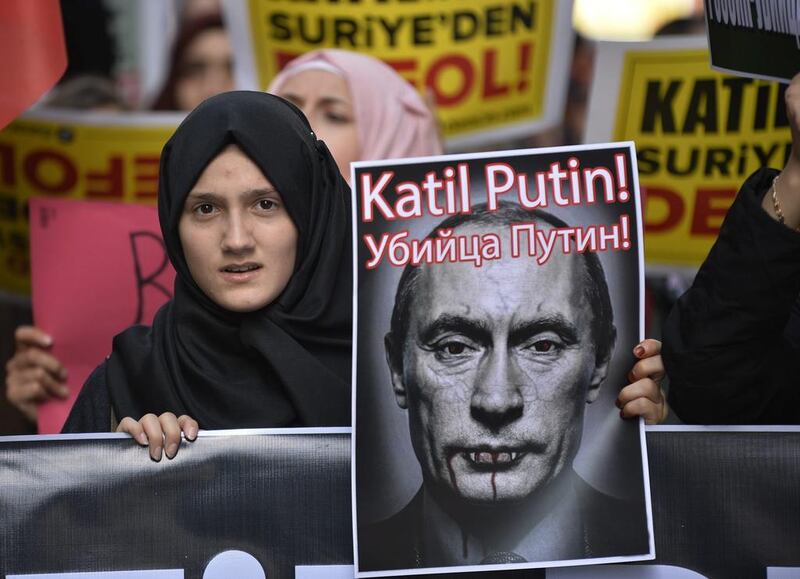Russia’s military intervention in Syria should not have taken the United States by surprise.
Moscow has made it clear over the course of the civil war that it is determined to protect its vital interests in the country – chiefly the preservation of the Syrian regime, the army and state institutions.
It has demonstrated that commitment through four years of diplomatic, economic and military support to the regime, repeatedly insisting that its ally, president Bashar Al Assad, be included in any settlement to end the war.
The latest direct Russian military involvement is just an intensification of that policy which has remained steadfast for four years.
While the US has offered muddled and conflicting positions throughout the Syrian civil war, the Russians have been consistent and predictable in their approach.
Pundits are correct when they assert that Russia’s intervention is about propping up Mr Al Assad’s forces, and not exclusively aimed at the ISIL.
Russia is not deviating from its policy in Syria, but rather reinforcing a strategy that has faced setbacks in recent months due to impressive rebel gains in Idlib, Hama and Homs provinces.
The Kremlin’s strategy, and by default that of the Assad regime, has been to empower the government’s position on the battleground in order to strengthen Damascus and Moscow’s hands at the negotiating table.
This was to be achieved through defensive posturing, a source close to Mr Al Assad said one year ago.
The regime would effectively cede the east to ISIL, while maintaining control of the key urban centres of Damascus, Homs and Hama – or what the regime refers to as “Syria’s core” – with an adjoining link to the Alawite heartland of Latakia.
But the Syrian army and Iranian-backed militias have struggled this year to maintain its de facto boundaries, losing 18 per cent of territory it controlled between January and August this year – according to research by the IHS Conflict Monitor – and thus necessitating a Russian intervention to shore up its position.
While the regime has indeed lost control of most of the terrain – controlling only roughly 25 per cent of the country, according to the Syrian Observatory for Human Rights – it still rules over most of Syria’s remaining population.
This, as far as the regime is concerned, bestows continued legitimacy upon its claim to govern the country, and demonstrates to the West that it is still the main force in the country.
The regime’s plan – as outlined a year ago – was to survive in Syria’s core long enough until the US came around and agreed to what Mr Putin has been pressing Washington to do in recent weeks – support Mr Al Assad to defeat ISIL.
The regime has also been counting on the added pressure of terrorist attacks in the West and the massive influx of Syrian refugees to Europe to win such a concession. And it appears to be working. Recent remarks from several European countries and the US suggest a willingness to include Mr Al Assad in any transitional deal.
While Mr Barack Obama attempted to save face at the UN General Assembly last week by insisting Mr Al Assad had no future, the Russian intervention may have left Washington with no choice but to include the Syrian president in any transitional deal.
The Russians are no longer trying to convince the Americans diplomatically to adopt their approach to Syria – they are imposing it.
The Assad regime’s interim survival has now been guaranteed as a result of Russia’s intervention, and Moscow’s red lines have been freshly inked as a reminder to the rebels’ key backers in Turkey, Saudi Arabia and Qatar.
This was the interpretation of Salih Muslim, the head of the Kurdish Democratic Union Party (PYD), who expects Turkey to cancel any plans it may have had of sending its own troops into the war-torn country as a result of Moscow’s direct involvement.
Regime control of Syria’s core is Russia’s red line, hence its initial strikes have targeted rebel positions most threatening to this de facto boundary.
Russian influence in Syria, and the Middle East, is inextricably linked to the survival of its only ally in the region – Mr Al Assad.
While Iran has cultivated a new ally in Baghdad to project its power into the Arab world, Mr Al Assad serves as Russia’s only conduit for influence in the region.
Russia has the most to lose should Mr Al Assad fall, and thus has the most to fight for. Persistent speculation over the four years that Russia would at some stage abandon Mr Al Assad was wishful to say the least.
Its current intervention should put to rest any talk of Moscow shifting to the West’s position on Mr Al Assad.
Russia aims to steer any transitional process in Syria towards its own interests, and that includes keeping Mr Al Assad and his regime at the helm of any post-war Syria.
With boots on the ground, it might achieve just that.
foreign.desk@thenational.ae





